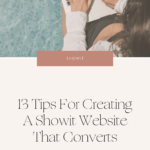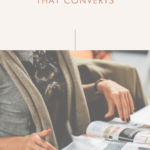First of all, creating a high-converting website may sound like black magic, but it doesn’t have to be. Thanks to Showit’s responsive interface, there are many simple ways to make sure your website is user-friendly and primed for conversions.
But, starting can be daunting. Making sure your headings and subheadings are strong… You need to strategically place opt-ins… You have to optimize the site for mobile (do NOT skip this part)… Where to begin?!
Never fear! Here at Hello Magic Studio, designing high-converting, strategy-based websites is second nature to us. Our motto? The easier it is for your people to navigate around your website, the better.
To help you get started, we’ve compiled 13 tips for building user-friendly, high-converting Showit websites. All you need to do is spot the things you need to tackle first!
1. Create headlines that leave an impression
Research shows the vast majority of people only read the headlines on a website. To clarify, you’ve got to make them count. They must be strong enough to leave an impression on your skimming reader. They have to pull your readers in so you can guide them towards essential information.
Our copywriter, Natalie, always tells us never to leave any “placeholder” copy in H2s and H3s. For example, don’t just say “About Us” on your About page. Instead, use the headline to actually say something about you. Use a statement that clearly defines what you are offering, who you are offering it to, and what makes your product or service different from your competitors. Essentially, you want to tell your reader something that captures the essence and purpose of your brand. This is what will draw them in and encourage them to keep reading (until they eventually hit that “buy” button!).
2. Break up big blocks of text for greater impact on SEO
You and I both know that reading a long block of words online is a serious drag. If your readers land on your web page or blog post and see one enormous paragraph, they’ll bounce right out of there. As a result, your search rankings will suffer because Google hates high bounce rates.
The good news is that we’ve got a few tips to break up your ideas and communicate your message into manageable pieces. You’ll retain the attention of your readers, lowering your bounce rate, and giving Google more reason to love your site.
Break paragraphs naturally
Unlike in your old college essays, on the web, you should make a paragraph every three to ten sentences (or less!). Think of where your ideas are changing naturally and be more liberal when splitting your sentences. That small line of space between paragraphs gives your reader’s eyes a break when reading on digital screens, which helps them process new ideas and thoughts.
Use your subheadings to reinforce topics
People skim through paragraphs instead of deeply reading when they’re processing content online, so these subheads help you break the text even more. Plus, adding subheads help boost your SEO and they’re an easy way to work in more keywords.
Add images to visually help your Showit website copy
Improving your readership scores on your site can depend on how many images you use to retain your reader’s attention. Although most in-text graphics and pictures aren’t always needed, you can use them if they help with your message. Images are another great way to break up paragraphs and text.
Place only essential information in your Showit website copy
When people search for your website, they are not there for fun and to sightsee what you’ve laid out for them. They’re there to get specific information that helps them solve a problem. Less is always more. Instead of trying to dazzle your audience with ALL THE INFO, get rid of anything that doesn’t answer essential questions or really help sell your businesses.
3. Be thoughtful about your visual brand identity
When you have a professionally designed brand identity, it makes people want to stick around. Make sure you have consistent high-quality brand imagery throughout your website that your ideal clients would be attracted to. When your people are going all heart-eyes over your gorgeous brand colours, logo, and fonts, they’ll spend more time creeping you (thus, lowering that bounce rate).
Ready to invest in professional branding? Learn more about our signature brand package here.
4. Source high-quality imagery
On a similar note, your images have a huge impact on your website and your readers. Anything that feels low quality, cheesy or too generic isn’t helpful. Definitely, prioritize high-quality images. Even better, use images of YOU as the business owner. Images of yourself help your readers get a glimpse of who you are. Above all, humans like to connect with other humans after all! It’s the same with your clients. If you’re showcasing a testimonial from them, don’t just get an image from their social media profile. Ask them for a high quality image of themselves. It all makes a big difference in positioning you as a powerful, professional business.
5. Showcase videos on your Showit website
From short Instagram stories or Tiktok clips to out-of-this-world immersive video experiences, video is Queen. Quite simply, you can communicate better, louder, and clearer if you say it with video. Moreoever, your website can use aesthetic videos instead of static images. Just like in Harry Potter how they have newspapers with moving images! Our favourite place to find excellent and FREE stock videography is Pexels. You can check out our ever-growing collection of excellent website stock imagery here.
6. Leverage testimonials on your Showit website
Testimonials from your clients are an amazing way to illustrate the transformation you help your people achieve. So, get those testimonials on your website! It’s an excellent way to build credibility for your products or services. But don’t make the same mistake of copying the ENTIRE testimonial. Pull out the best bits and sprinkle them in essential areas, like near CTAs and prices. Why say how amazing you are when other people can do it for you?
7. Increase website points of interaction
Did you know many people prefer to click through sliders to understand your process rather than scroll down a long page of text? We’ve heard this from several clients lately who loved how we set up our services page. This is just one way you can increase website interaction.
When you give your reader a chance to interact with your website, it helps with your engagement and keeps them occupied to explore more of what you offer. It’s like breaking a one-way communication wall. Instead of letting them scroll through text, you give them the ability to actively engage with your content and various elements. It could be in the form of an online chatbox, responding to comments, indicating preferences, and interesting shapes or designs.
8. Optimise your images for faster website loading
Speed is the forerunner of the game in web design. As a result, just because you’ve got a sparkling new, incredibly designed website, if your images don’t load in the first five seconds, you can kiss those sweet conversions goodbye.
With any website building site, check their suggested image sizes for your website. For instance, Showit suggests images in the following formats: JPG, PNG, and GIF. For our background images, they recommend that the JPGs be 3500px wide. We personally use TinyPNG for all our image compressing needs.
9. Place your opt-ins where your readers can see them
Give your audience a reason to stay by giving them a gift or a freebie. These opt-ins are a key part of your lead-generating strategy. This allows you to build an email list and grow your trust with your target audience. There are a lot of places where you can put them on your website. Make them valuable, enticing, and value-packed. Give your readers a reason to subscribe. For example, you can solve a specific problem that they have, give them a quick win, and lead them to your opt-in.
10. Leverage those CTAs
A call to action (CTA) is a prompt on your website that tells your readers to take some specified action. It’s typically a command or an action phrase, such as “Sign Up Now” or “Share on social media” that takes the form of a button or a hyperlink. Without a clear CTA, your user may not know the next steps to take to sign up for a newsletter or purchase a product. They will likely leave the site without accomplishing anything. Use a CTA at the end of every page, or anywhere that might require your visitor to take action. Remember, we have to walk the visitor by hand through the site. We can’t just expect them to know where to go next, we have to show them.
11. Add a “Featured In” or “Trusted By” section
Here at HMS, we call this a “logo cloud”. These are a collection of logos from businesses you’ve worked with or media where you’ve been featured. Logo clouds or “featured in” sections help maximize visual and emotional impact for your brand by building serious street cred (i.e. authority).
Having a logo cloud helps you show credibility for your work since you’ve been recognized by other trusted brands. You can also use this section to present what kind of clients you have been working with. This helps other people, who are interested in working with you, see that your work is of high quality and the best choice. For a few visual examples, check out these:
- The Hello Magic Studio homepage: https://hellomagic.io
- Our client, Plant Centered Nutrition’s media page: https://plantcenterednutrition.us/media
- Our client, Alix Turoff’s homepage: https://www.alixturoffnutrition.com
12. Tidy up the navigation bar and footer
This is a huge mistake we often see in our clients’ old websites. When you overflow your navigation bar and footer with too many buttons or links that go to who knows where, you increase the chances your visitors are going to get confused and leave.
Always opt for a simple navigation bar and footer that shows where you want your audience to go. A good way of doing that is to test out how you navigate your website as if you were a visitor. Think from their perspective as if you don’t know anything about your brand or company.
13. Make your website as mobile-friendly as possible
Your website is the face of your brand. It’s a place where your audience gets a feel for who you are and what you offer. You want to appear aesthetically pleasing, but also user-friendly. In other words, it’s more than just design. It’s about functionality and making it easy for your visitors to navigate your site. Here’s what your audience can say about the impact your website has on your brand:
- 74% of your visitors are more likely to return to a mobile-friendly website
- 39% of them will stop engaging with a website if the images take too long to load
- 75% of credibility comes from the website design
You are serving your audience in a generation where the use of mobile phones is a necessity. They want to connect and get what they’re looking for quickly. If you’re not optimized for mobile, you can’t offer your customers immediate service. Another important thing to note is Google prioritizes mobile-friendly websites. Above all, this little tweak in the algorithm happened in 2015 where websites that are optimized for mobile rank better than those that don’t.
Where to next?
Learn how to boost your Showit website SEO with this 10-minute task
If you’re a new business owner and you need a foolproof strategy to name your business, we’ve got a real treat for you!
Ever heard of the One Concept Method? Want to know why we use it to create strategy-led brand design? Read more about it here.
At Hello Magic, we are in love with Showit. We’re all about building beautiful websites that attract your dream customers and the only thing better than a gorgeous online home is a gorgeous online home that converts. To get the best of both worlds, you need to know how to optimise your Showit site for SEO.

Excellent photography is one of the key ingredients in a show-stopping, stand-out-from-the-crowd kind of website. Here are our top tips for planning a brand photoshoot that will produce website-worthy images.

“Should I use Showit or Squarespace for my website?” This is a question we hear from many clients. And no wonder. Figuring out whether you should create a website using Squarespace or Showit is like trying to find a consensus over whether pineapple belongs on pizza or not.

Are you considering investing in professional branding or a rebranding project but unsure if it’s even worth it? It’s a valid concern. After all, there are many factors to take into account when making such an important decision for your business. To help you out, we’ll share with you a few cold, hard stats about the benefits of branding that just might convince you to take the plunge.

Template or custom: which is right for you? In this post, we compare all the differences between a custom Showit design and a Showit premade template to figure out which option is best for you and your business.

At Hello Magic, we are in love with Showit. We’re all about building beautiful websites that attract your dream customers and the only thing better than a gorgeous online home is a gorgeous online home that converts. To get the best of both worlds, you need to know how to optimise your Showit site for SEO.

Are you considering investing in professional branding or a rebranding project but unsure if it’s even worth it? It’s a valid concern. After all, there are many factors to take into account when making such an important decision for your business. To help you out, we’ll share with you a few cold, hard stats about the benefits of branding that just might convince you to take the plunge.






